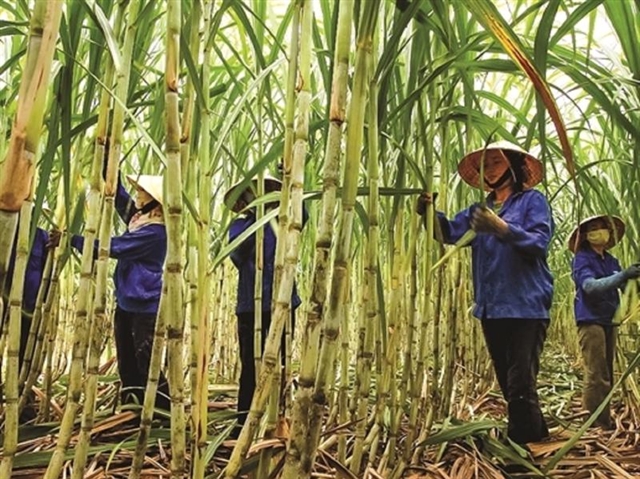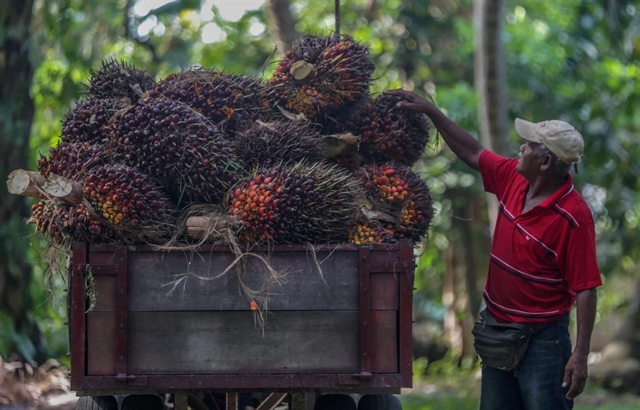 Economy
Economy


|
| Việt Nam's average sugarcane yield was 64.5 tonnes per hectare in 2021, an increase of 2.5 per cent on year. Photo congthuong.vn |
HÀ NỘI - The domestic sugarcane and sugar industry expects to continue output growth with the 2022-23 crop thanks to the positive production performance and the tariff policy's efficiency for importing sugar.
According to the Việt Nam Sugar Association, the total area supplying sugarcane is expected to reach 151,305 hectares in the 2022-23 crop.
The crop's output of sugarcane for processing is about 8.76 million tonnes, with the average yield at 66.2 tonnes per hectare. Sugar production from sugarcane was 870,930 tonnes, an increase of more than 124,000 tonnes compared to the 2021-22 crop.
Besides that, this positive forecast is supported by applying measures of trade remedies for several cane sugar products imported from Cambodia, Indonesia, Laos, Malaysia and Myanmar within five years.
In the 2022-23 crop, only 24 sugar processing factories are expected to operate, equal to the number of factories operating in the 2021-22 season, with a total design capacity of 122,200 tonnes of sugarcane per day.
In this crop, according to sugar processing enterprises, to ensure sustainable development, Việt Nam's sugar industry needs to strengthen and develop the linkage in the sugarcane production chain.
"The enterprises also need to join hands to build a healthy sugar market. The trade remedies for the sugar products are not only against dumping and subsidy but also to stabilise the market," said Nguyễn Văn Lộc, chairman of the Việt Nam Sugar Association.
In addition, it is necessary to make transparency in the analysis of the commercial cane sugar (CCS) index and evaluation of removing the impurity rate of sugar in mills. That will bring benefits to farmers and enterprises.
Previously, Việt Nam had more than 300,000 hectares for planting sugarcanes. However, in recent years, more than half of the total sugarcane area has been converted to other crops by farmers.
Therefore, the sugarcane and sugar industry needs to restore the sugarcane material area with 250,000 hectares in 2025 and 300,000 hectares in 2028.
To achieve those development goals, the Việt Nam Sugar Association recommends that the Ministry of Agriculture and Rural Development prioritise funding for researching sugarcane varieties and implementing sugarcane variety projects in key sugarcane production areas.
It proposes to add sugarcane to the list of eligible crops receiving insurance because natural disasters affect sugarcane farmers.
The association also requests the Government and the ministry to support it in building a national traceability management system for sugar products. This system could manage and identify smuggled and fraudulent sugar products consumed on the market.
It believes that preventing smuggled and fraudulent products needs the participation and cooperation of all association members to enhance effectiveness in this activity.
According to the association, in the 2021-22 crop, the total of raw materials for processing reached about 7.5 million tonnes of sugarcane, an increase of 11.6 per cent compared to the 2020-21 crop.
About 24 factories processed 949,219 tonnes of sugar, including 746,899 tonnes from domestic sugarcane and the rest from imported raw sugar.
In the 2021-22 crop, the price of raw sugarcane increased by about VNĐ100,000-150,000 per tonne compared to the previous crop.
That made many farmers return to sugarcane production, leading to an increase in sugarcane yield. Therefore, although the area of sugarcane has decreased, the output of sugarcane was the same as that of the previous crop.
The total sugarcane planting area nationwide in 2021 was 166,902 hectares, down from 185,455 hectares in 2020. Việt Nam's average sugarcane yield was 64.5 tonnes per hectare in 2021, an increase of 2.5 per cent per year. VNS




